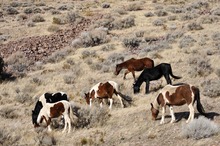A recent independent report on horse roundups in the West concludes the U.S. government would be better off investing in fertility control of the wild horses and letting nature cull excess herds instead of spending millions to house them in overflowing holding pens.

Herd of wild mustangs near Reno, Nevada
Removal of nearly 100,000 horses from the Western range over the past decade is probably having the opposite effect of its intention to ease ecological damage and reduce overpopulated herds.
© 2013 by Carien Schippers
A 14-member panel assembled by the National Science Academy's National Research Council, at the request of the Bureau of Land Management, concluded BLM's removal of nearly 100,000 horses from the Western range over the past decade is probably having the opposite effect of its intention to ease ecological damage and reduce overpopulated herds.
By stepping in prematurely when food and water supplies remain adequate, and with most natural predators long gone, the land management agency is producing artificial conditions that ultimately serve to perpetuate population growth, the committee reported.
The research panel sympathized with BLM's struggle to find middle ground between horse advocates and ranchers who see the animals as unwelcome competitors for forage.
The report says the current method may work in the short term, but results in continually high population growth are exacerbating the long-term problem.
The American Wild Horse Preservation Fund, a national coalition of more than 50 advocacy groups, said the report makes a strong case for an immediate halt to the roundups.
"This is a turning point for the decades-long fight to protect America's mustangs," said Neda DeMayo, president of the coalition's Return to Freedom.
The National Cattlemen's Beef Association is among the livestock groups that have voiced support in the past for aggressive, increased use of fertility control but remain adamantly opposed to curtailing roundups. Horse advocates themselves are not united behind the idea of stepping up use of contraception on the range.
"We are grateful that the National Academy of Science recommends stopping cruel roundups, but we challenge their decision to control alleged overpopulation like a domestic herd with humans deciding who survives and breeds," said Anne Novak, executive director of Protect Mustangs in San Francisco.
The conflict has raged for decades but has intensified in recent years for cash-strapped federal land managers with skyrocketing bills for food and corrals and no room for incoming animals.
Rep. Raul Grijalva, D-Ariz., said the report should serve as a wakeup call to bring changes he and others in Congress have urged for years.
"These unsustainable practices are a waste of taxpayer money and jeopardize the health and safety of wild horses across the West," he said.
BLM officials said they welcomed the recommendations to help in their effort to make the program more cost-effective. Spokesman Tom Gorey said the agency "needs and wants to do a better job" managing horses, but said those advocating an end to all roundups are misguided.
Panel members said they found little scientific basis for establishing what BLM considers to be appropriate, ecologically based caps on horse numbers and even less basis for estimating the overall population itself.
"It seems that the national statistics are the product of hundreds of subjective, probably independent, judgments and assumptions by range managers and administrators," the report said.
BLM's current population estimate likely is anywhere from 10 percent to 50 percent short of the true level, the report said.
The number of animals at holding facilities surpassed the estimated number on the range in 10 Western states earlier this year for the first time since President Richard Nixon signed the Free-Roaming Horses and Burros Act of 1971.
The agency averaged removing 8,000 horses from the range annually from 2002 to 2011. Last year, it spent 60 percent of its wild horse budget on holding facilities alone, more than $40 million, the committee said.
"The goal would be to manage horses better on the range so that any numbers that would be taken off would be matched with the adoption demand, which is not the current case."
